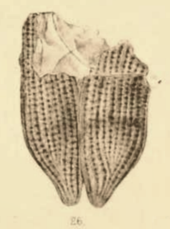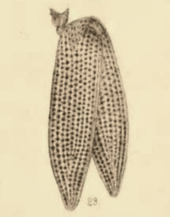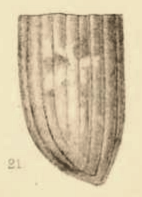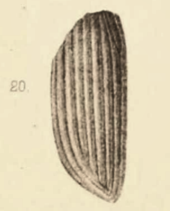Coldwater Beds
| Coldwater Beds Stratigraphic range: Ypresian (Wasatchian) ~ | |
|---|---|
| Type | Formation |
| Unit of | |
| Sub-units | & |
| Overlies | |
| Thickness | 230 m (750 ft) |
| Lithology | |
| Primary | Mudstone |
| Other | Shale, tuff, coal |
| Location | |
| Coordinates | 50°06′N 120°30′W / 50.1°N 120.5°WCoordinates: 50°06′N 120°30′W / 50.1°N 120.5°W |
| Approximate paleocoordinates | 54°48′N 103°30′W / 54.8°N 103.5°W |
| Region | British Columbia |
| Country | |
| Extent | Okanagan Highlands |
| Type section | |
| Named for | Coldwater River |
| Named by | Dawson |
| Year defined | 1895 |
 Coldwater Beds (Canada) | |
The Coldwater Beds are a geologic formation of the Okanagan Highlands in British Columbia, Canada. They preserve fossils dating back to the Ypresian stage of the Eocene period, or Wasatchian in the NALMA classification.[1]
The formation comprises mudstones, shales and tuffs deposited in a lacustrine environment and has provided many insect fossils, as well as indeterminate birds and fossil flora.[2]
Description[]
The Coldwater Beds were defined by Dawson (1895) based on a section along the Coldwater River in the Okanagan Highlands.[3] The formation reaches a thickness of 230 metres (750 ft),[4] and comprises mudstones, shales and tuff deposited in a lacustrine environment. U-Pb dating of thick tephra, combined with Ar-Ar dates of sanidine from same bed provided an Early Eocene age. The tephra was deposited within insect-bearing shales.[1]
Climate[]

During the Early Eocene, the climate of much of northern North America was warm and wet, with mean annual temperatures (MAT) as high as 20 °C (68 °F), mean annual precipitation (MAP) of 100 to 150 centimetres (39 to 59 in), mild frost-free winters (coldest month mean temperature >5 °C (41 °F)), and climatic conditions that supported extensive temperate forest ecosystems.[5]
The Quilchena fossil locality is dated to 51.5 ± 0.4 Ma corresponding to the (EECO), and is reconstructed as the warmest and wettest of the Early Eocene upland sites from the Okanagan Highlands of British Columbia and northern Washington State. Mean annual temperature (MAT) is estimated from leaf margin analysis as 16.2 ± 2.1 °C (61.2 ± 3.8 °F) and 14.6 ± 4.8 °C (58.3 ± 8.6 °F). Using bioclimatic analysis of 45 nearest living relatives, a moist mesothermal climate is indicated (MAT 12.7 to 16.6 °C (54.9 to 61.9 °F); cold month mean temperature (CMMT) 3.5 to 7.9 °C (38.3 to 46.2 °F) and mean annual precipitation (MAP) of 103 to 157 centimetres (41 to 62 in)/yr. Leaf size analysis estimates MAP at 121 ± 39 centimetres (48 ± 15 in)/y.[6]
Fossils[]

(1890 illustration)

(1890 illustration)

(1890 illustration)

(1890 illustration)

(1890 illustration)
A wide variety of fossils occur in the formation, including abundant fish remains, insects, and plants, and rare occurrences of molluscs, ostracods, and birds:[1]
Flora[]
Fossil plants were first reported from the Coldwater Beds at the Quilchena site and nearby by Penhallow (1908)[7] with an expanded taxonomic list given by Mathewes et al (2016).[8]
- Pteridophytes
- Ginkgophytes
- Pinophytes
- Abies[8]
- cf Amentotaxus[8]
- Calocedrus[8]
- Chamaecyparis[8]
- Glyptostrobus[8]
- Keteleeria[8]
- Metasequoia[8]
- Picea[8]
- Pinus[8]
- Pseudolarix[8]
- Sequoia[8]
- Taxodium[8]
- Thuja[8]
- Tsuga[8]
- Angiosperms
- Acer[8]
- cf. Aesculus[8]
- †[8]
- †Betula leopoldae[8]
- Bignoniaceae[8]
- †[8]
- †Comptonia columbiana[8]
- Cornus [8]
- Corylopsis[8]
- Dipteronia[8]
- cf. Disanthus[8]
- †Eucommia montana[9]
- †Eucommia rolandii[9]
- cf. Exbucklandia[8]
- Fagus[8]
- †Florissantia quilchenensis[10]
- Fraxinus[8]
- Hovenia[8]
- †/[8]
- Nyssa[8]
- Pieris[8]
- †[8]
- cf. Pterocarya[8]
- Rhus[8]
- cf. Sambucus[8]
- Sassafras[8]
- Ternstroemia[8]
- cf. Gordonia[8]
- Tilia[8]
- Trochodendron[8]
- †Ulmus okanaganensis[7]
Pollen taxa[]
- Ginkgophytes
- Pinophytes
- Angiosperms
- Alnus[8]
- Carya[8]
- †[8]
- Liquidambar[8]
- †[8]
- cf. Platanus[8]
- Pterocarya[8]
- †Sabal ?florisanti[7]
- Tilia[8]
- Ulmus[8]
Insects[]
- Blattaria
- Coleoptera
- cf. Amara sp.[11]
- † Scudder, 1879[12][13]
- † Scudder, 1879[12][13]
- † Scudder, 1879[12][13]
- Carabidae indet.[11]
- † Scudder, 1879[12]
- Curculionidae indet.[11]
- cf. Erotylidae indet.[11]
- † Scudder, 1879[12]
- Omaliinae indet.[11]
- [8]
- Scarabaeoidea indet.[11]
- Dermaptera
- Forficulina indet.[11]
- Diptera
- Plecia angustipennis[14]
- Plecia canadensis[14]
- Plecia pictipennis[15]
- Mycetophilidae indet.[11]
- Pipunculidae indet.[11]
- Pipunculinae indet.[16]
- [11]
- Syrphidae indet.[11]
- Tipulidae indet.[11]
- Hemiptera
- [15]
- Aphididae indet.[11]
- Cercopoidea indet.[11]
- Cicadellidae indet.[11]
- Cydnidae indet.[11]
- Gerridae indet.[11]
- Megymeninae indet.[11][8]
- cf. Pentatomidae indet.[11]
- Hymenoptera
- [17]
- Halictus? savenyei[18]
- Braconidae indet.[19]
- Formicidae indet.[11]
- Ichneumonidae indet.[11]
- Tenthredinidae indet.[19]
- Trigonalidae indet.[19]
- Vespidae indet.[11]
- Mecoptera
- Neuroptera
- [21]
- Palaeopsychops dodgeorum[22]
- Palaeopsychops douglasae[21]
- Wesmaelius mathewesi[23]
- Orthoptera
- Trichoptera
- Phryganeidae indet.[11]
- Trichoptera indet.[11]
Fish[]
Birds[]
Mammals[]
Correlations[]

The formation has been correlated with the floras including the Allenby Formation, , , and Driftwood Canyon site of British Columbia, along with the Klondike Mountain Formation of Washington State.[5] Additionally its correlated with the Margaret Formation of Ellesmere Island, Nunavut, the Chickaloon Formation of Alaska, , Chuckanut and , all of similar age.[5] The flora of the Coldwater Beds has been correlated to the of southeastern British Columbia.[7] The formation also correlates with the , and in Washington, United States.[3]
See also[]
References[]
- ^ a b c Coldwater Beds at Fossilworks.org
- ^ Quilchena at Fossilworks.org
- ^ a b Pearson, R. C.; Obradovich, D. (1977). "Eocene Rocks in Northeast Washington- Radiometric Ages and Correlation". . 1433: 9–10.
- ^ Tribe, Selina (2004). Cenozoic Drainage History of Southern British Columbia - PhD thesis. Simon Fraser University. pp. 41, 67, 112.
- ^ a b c ; ; ; ; , and . 2020. Paleobotanical proxies for early Eocene climates and ecosystems in northern North America from middle to high latitudes. Climate of the Past 16. 1387, 1390-1391. Accessed 2020-09-05.
- ^ Mathewes, 2015, p.2
- ^ a b c d Greenwood, David R.; Pigg, Kathleen B.; Basinger, James F.; DeVore, Melanie L. (2015). "A review of paleobotanical studies of the Early Eocene Okanagan Highlands floras of British Columbia, Canada and Washington, USA". Canadian Journal of Earth Sciences: 15, 18–19.
- ^ a b c d e f g h i j k l m n o p q r s t u v w x y z aa ab ac ad ae af ag ah ai aj ak al am an ao ap aq ar as at au av aw ax ay az ba bb bc bd be bf bg bh bi bj bk bl bm Mathewes, R. W.; Greenwood, D. R.; Archibald, S. B. (2016). "Paleoenvironment of the Quilchena flora, British Columbia, during the Early Eocene Climatic Optimum" (PDF). Canadian Journal of Earth Sciences. 53 (6): 574–590. Bibcode:2016CaJES..53..574M. doi:10.1139/cjes-2015-0163. hdl:1807/71979.
- ^ a b Call, V.B.; Dilcher, D.L. (1997). "The fossil record of Eucommia (Eucommiaceae) in North America" (PDF). American Journal of Botany. 84 (6): 798–814. doi:10.2307/2445816. PMID 21708632.
- ^ Manchester, S. R (1992). "Flowers, fruits, and pollen of Florissantia, an extinct Malvalean genus from the Eocene and Oligocene of western North America". American Journal of Botany. 79: 996–1008.
- ^ a b c d e f g h i j k l m n o p q r s t u v w x y z Archibald, S. B.; Mathewes, R. W. (2000). "Early Eocene insects from Quilchena, British Columbia, and their paleoclimatic implications". Canadian Journal of Zoology. 78: 1441–1462.
- ^ a b c d e Scudder, S. H (1879). "Appendix A. The fossil insects collected in 1877, by Mr. G.M. Dawson, in the interior of British Columbia". Geological Survey of Canada, Report of Progress for. 1877–1878: 175–185.
- ^ a b c Scudder, S. H (1895). "Canadian fossil insects, myriapods and arachnids, Vol II. The Coleoptera hitherto found fossil in Canada". Geological Survey of Canada Contributions to Canadian Palaeontology. 2: 5–26.
- ^ a b Rice, H. M. A (1959). "Fossil Bibionidae (Diptera) from British Columbia". Geological Survey of Canada Bulletin. 55: 1–36.
- ^ a b c Handlirsch, A (1910). "Canadian fossil Insects. 5. Insects from the Tertiary lake deposits of the southern interior of British Columbia, collected by Mr. Lawrence M. Lambe". . 2: 93–129.
- ^ Archibald, S. B.; Kehlmaier, C.; Mathewes, R. W. (2014). "Early Eocene big headed flies (Diptera: Pipunculidae) from the Okanagan Highlands, western North America". The Canadian Entomologist. 146: 429–443.
- ^ Pulawski, W. J.; Rasnitsyn, A. P.; Brothers, D. J.; Archibald, S. B. (2000). "New genera of Angarosphecinae: Cretosphecium from Early Cretaceous of Mongolia and Eosphecium from Early Eocene of Canada (Hymenoptera: Sphecidae)". Journal of Hymenoptera Research. 9: 34–40.
- ^ Engel, M. S.; Archibald, S. B. (2003). "An Early Eocene bee (Hymenoptera: Halictidae) from Quilchena, British Columbia". The Canadian Entomologist. 135: 63–69.
- ^ a b c Archibald, S. B.; Rasnitsyn, A. P.; Brothers, D. J.; Mathewes, R. W. (2018). "Modernisation of the Hymenoptera: ants, bees, wasps, and sawflies of the early Eocene Okanagan Highlands of western North America". The Canadian Entomologist. 150: 250–257.
- ^ a b Archibald, S. B.; Mathewes, R. W.; Greenwood, D. R. (2013). "The Eocene apex of panorpoid scorpionfly family diversity". Journal of Paleontology. 87: 677–695.
- ^ a b Archibald, S. B.; Makarkin, V. N. (2006). "Tertiary Giant Lacewings (Neuroptera: Polystoechotidae): revision and description of new taxa from Western North America and Denmark". Journal of Systematic Palaeontology. 4: 119–155.
- ^ Makarkin, V. N.; Archibald, S. B. (2003). "Family affinity of the genus Palaeopsychops Andersen with description of a new species from the Early Eocene of British Columbia, Canada (Neuroptera: Polystoechotidae)". Annals of the Entomological Society of America. 96: 171–180.
- ^ Makarkin, V. N.; Archibald, S. B.; Oswald, J. D. (2003). "New Early Eocene brown lacewings (Neuroptera: Hemerobiidae) from western North America". The Canadian Entomologist. 135: 637–653.
- Ypresian North America
- Paleontology in British Columbia
- Coldwater Beds

